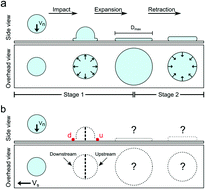Understanding the drop impact on moving hydrophilic and hydrophobic surfaces†
Abstract
In this paper, a systematic study was performed to understand the drop impact on hydrophilic and hydrophobic surfaces that were moving in the horizontal direction. Drops (D0 = 2.5 mm) of liquids with three different viscosities were used. Wide ranges of drop normal velocity (0.5 to 3.4 m s−1) and surface velocity (0 to 17 m s−1) were studied. High speed imaging from the top and side was used to capture the impact phenomena. It was found that drop impact behavior on a moving surface significantly differs from that on a stationary surface at both the lamella extension stage (i.e. t ≤ tmax) and the retraction stage (t > tmax). Starting with the lamella extension stage, it was observed that the drop spreads asymmetrically over a moving surface. It was also found that the splashing behavior of the drop upon impact on a moving surface, unlike the understanding in the literature, is azimuthally different along the lamella contact line. In the case of the drop spreading over a moving surface, the surface movement stretches the expanded lamella in the direction of the surface motion. For hydrophilic surfaces, the stretched lamella pins to the surface and moves with the surface velocity; however, for hydrophobic surfaces, the lamella recoils during such stretching. A new model was developed to determine the splashing threshold of the drop impact on a moving surface. The model is capable of describing the azimuthally different behavior of the splashing which is a function of normal capillary and Weber numbers, surface velocity, and surface wettability. It was also found that the increase of the viscosity decreases the splashing threshold. Finally, comprehensive regime maps of the drop impact outcome on a moving surface were provided for both t ≤ tmax and t > tmax stages.



 Please wait while we load your content...
Please wait while we load your content...